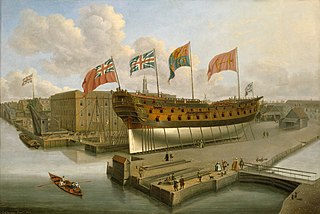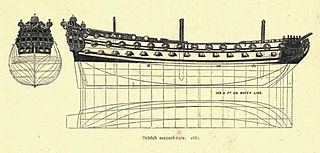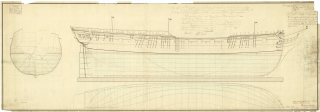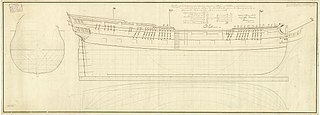
In the rating system of the Royal Navy used to categorise sailing warships, a fifth rate was the second-smallest class of warships in a hierarchical system of six "ratings" based on size and firepower.

In the rating system of the Royal Navy used to categorise sailing warships, a fifth rate was the second-smallest class of warships in a hierarchical system of six "ratings" based on size and firepower.
The rating system in the Royal Navy as originally devised had just four rates, but early in the reign of Charles I, the original fourth rate (derived from the "Small Ships" category under his father, James I) was divided into new classifications of fourth, fifth, and sixth rates. While a fourth-rate ship was defined as a ship of the line, fifth and the smaller sixth-rate ships were never included among ships-of-the-line. Nevertheless, during the Anglo-Dutch Wars of the 17th century, fifth rates often found themselves involved among the battle fleet in major actions. Structurally, these were two-deckers, with a complete battery on the lower deck, and fewer guns on the upper deck (below the forecastle and quarter decks, usually with no guns in the waist on this deck).
The fifth rates at the start of the 18th century were small two-deckers, generally either 40-gun ships with a full battery on two decks, or "demi-batterie" ships, carrying a few heavy guns on their lower deck (which often used the rest of the lower deck for row ports) and a full battery of lesser guns on the upper deck. The former were gradually phased out, though, as the low freeboard (the height of the lower deck gunport sills above the waterline) meant that opening the lower deck gunports in rough weather was often impossible. The 40-gun (or later 44-gun) fifth rates continued to be built until the latter half of the 18th century (a large number were built during the American Revolutionary War). From mid-century, a new fifth-rate type was introduced - the classic frigate, with no gun ports on the lower deck, and the main battery of from 26 to 30 guns disposed solely on the upper deck, although smaller guns were mounted on the quarterdeck and forecastle.
Fifth-rate ships served as fast scouts or independent cruisers, and included a variety of gun arrangements. The fifth rates of the 1750s generally carried a main battery of twenty-six 12-pounders on the upper deck, with six 6-pounders on the quarterdeck and forecastle (a few carried extra 6-pounders on the quarterdeck) to give a total rating of 32 guns. Larger fifth rates introduced during the late 1770s carried a main battery of twenty-six or twenty-eight 18-pounders, also with smaller guns (6-pounders or 9-pounders) on the quarterdeck and forecastle. Displacement ranged from 700 to 1450 tons, with crews of 215 to 294 men.
To be posted aboard a fifth-rate ship was considered an attractive assignment. Fifth rates were often assigned to interdict enemy shipping, offering the prospect of prize money for the crew.
Fifth-rate frigates were considered useful for their combination of manoeuvrability and firepower, which, in theory, would allow them to outmanoeuvre an enemy of greater force and run down one of lesser force. For this reason, frigates of this sort were commonly used in patrol and to disrupt enemy shipping lanes much as heavy cruisers would later in history.

In the rating system of the Royal Navy, a third rate was a ship of the line which from the 1720s mounted between 64 and 80 guns, typically built with two gun decks. Years of experience proved that the third rate ships embodied the best compromise between sailing ability, firepower, and cost. So, while first-rates and second-rates were both larger and more powerful, third-rate ships were the optimal configuration.

In the rating system of the Royal Navy used to categorise sailing warships, a first rate was the designation for the largest ships of the line. Originating in the Jacobean era with the designation of Ships Royal capable of carrying at least 400 men, the size and establishment of first-rates evolved over the following 250 years to eventually denote ships of the line carrying at least 80 guns across three gundecks. By the end of the eighteenth century, a first-rate carried no fewer than 100 guns and more than 850 crew, and had a measurement (burthen) tonnage of some 2,000 tons.

In 1603 all English warships with a complement of fewer than 160 men were known as 'small ships'. In 1625/26 to establish pay rates for officers, a six-tier naval ship rating system was introduced. These small ships were divided into three tiers: fourth-, fifth- and sixth-rates. Up to the end of the 17th century, the number of guns and the complement size were adjusted until the rating system was actually clarified. A 'fourth-rate' was nominally a ship of over thirty guns with a complement of 140 men.

In the 18th century and most of the 19th, a sloop-of-war in the Royal Navy was a warship with a single gun deck that carried up to eighteen guns. The rating system covered all vessels with 20 guns and above; thus, the term sloop-of-war encompassed all the unrated combat vessels, including the very small gun-brigs and cutters. In technical terms, even the more specialised bomb vessels and fireships were classed as sloops-of-war, and in practice these were employed in the sloop role when not carrying out their specialised functions.

In the rating system of the Royal Navy used to categorise sailing warships, a second-rate was a ship of the line which by the start of the 18th century mounted 90 to 98 guns on three gun decks; earlier 17th-century second rates had fewer guns and were originally two-deckers or had only partially armed third gun decks. A "second rate" was the second largest class of warships in a hierarchical system of six "ratings" based on size and firepower.

In the rating system of the Royal Navy used to categorise sailing warships, a sixth-rate was the designation for small warships mounting between 20 and 28 carriage-mounted guns on a single deck, sometimes with smaller guns on the upper works and sometimes without. It thus encompassed ships with up to 30 guns in all. In the first half of the 18th century the main battery guns were 6-pounders, but by mid-century these were supplanted by 9-pounders. 28-gun sixth-rates were classed as frigates, those smaller as 'post ships', indicating that they were still commanded by a full ('post') captain, as opposed to sloops of 18 guns and less, which were under commanders.

The rating system of the Royal Navy and its predecessors was used by the Royal Navy between the beginning of the 17th century and the middle of the 19th century to categorise sailing warships, initially classing them according to their assigned complement of men, and later according to the number of their carriage-mounted guns. The rating system of the Royal Navy formally came to an end in the late 19th century by declaration of the Admiralty. The main cause behind this declaration focused on new types of gun, the introduction of steam propulsion and the use of iron and steel armour which made rating ships by the number of guns obsolete.

HMS Cornwall was an 80-gun, third rate, ship of the line built for the Royal Navy in the 1690s. She served in the War of the Grand Alliance, and in her first year took part in the Battle of Barfleur and the action at La Hougue.

HMS Cornwall was a 74-gun third-rate Vengeur-class ship of the line built for the Royal Navy in the 1810s. She spent most of her service in reserve and was converted into a reformatory and a school ship in her later years. The ship was broken up in 1875.

HMS Amazon, was a 36-gun Amazon-class frigate, built at Rotherhithe in 1795 to a design by Sir William Rule. Carrying a main battery of 18-pounder long guns, she was the first of a class of four frigates. She had a short but eventful career during the French Revolutionary War, which she spent in the Channel and Western Approaches, part of a frigate squadron under Sir Edward Pellew. She was wrecked in Audierne Bay in 1797, following an action on 13 January with the French ship-of-the-line, Droits de l'Homme.

HMS Lion was a 80-gun second rate Vanguard-class ship of the line built for the Royal Navy in the 1840s. She was fitted with steam propulsion in 1858–1859. In 1871 Lion was converted into a training ship at HM Dockyard, Devonport. The ship was sold for scrap in 1905.
HMS Falmouth was a 50-gun fourth-rate ship of the line built for the Royal Navy in the first decade of the 18th century. The ship participated in several battles during the War of the Spanish Succession (1701–15) and the War of Jenkins' Ear (1739–48).

The 1745 Establishment was the third and final formal establishment of dimensions for ships to be built for the Royal Navy. It completely superseded the previous 1719 Establishment, which had subsequently been modified in 1733 and again in 1741. Although partially intended to correct the problems of the ships built to the earlier Establishments, the ships of the 1745 Establishment proved just as unsatisfactory, and important changes in the make-up of the Admiralty and Navy Boards finally led to the end of the establishment era by around 1751.
The Adventure-class ship was a class of eight 44-gun sailing two-decker warships of the Royal Navy, classed as a fifth rate like a frigate, but carrying two complete decks of guns, a lower battery of 18-pounders and an upper battery of 12-pounders. This enabled the vessel to deliver a broadside of 318 pounds.

Post ship was a designation used in the Royal Navy during the second half of the 18th century and the Napoleonic Wars to describe a sixth-rate ship that was smaller than a frigate, but by virtue of being a rated ship, had to have as its captain a post captain rather than a lieutenant or commander. Thus ships with 20 to 26 guns were post ships, though this situation changed after 1817.

The Nymphe class was a class of four 34/44-gun frigates of the French Navy, designed in 1781 by Pierre-Augustin Lamothe. The prototype (Nymphe) was one of the earliest of the frigates to be armed with 18-pounder long guns. The first two - Nymphe and Thétis - carried 34 guns comprising twenty-six 18-pounders on the upper deck and eight 8-pounders on the quarterdeck and forecastle. The latter two - Cybèle and Concorde - carried an increased armament of 44 guns comprising twenty-eight 18-pounders on the upper deck and twelve 8-pounders plus four 36-pounder obuses on the quarterdeck and forecastle. Thétis was retro-fitted by 1794 to carry the same increased armament as the last two; she was rebuilt at Rochefort from October 1802 to September 1803.

The Artois class were a series of nine frigates built to a 1793 design by Sir John Henslow, which served in the Royal Navy during the French Revolutionary and Napoleonic Wars.

HMS Janus was a 44-gun Roebuck-class fifth rate of the Royal Navy.

HMS Arethusa was a 46-gun Leda-class fifth-rate frigate built for the Royal Navy during the 1810s. The ship was never commissioned and was converted into a lazarette in 1836. She was renamed HMS Bacchus in 1844 and was further converted into a coal hulk in 1851–52. The ship was sold for scrap in 1883.

HMS Cato was a 50-gun Grampus-class fourth rate ship of the Royal Navy. One of a class of ships constructed for service in the American Revolutionary War, Cato was commissioned in 1782. She became the flagship of Sir Hyde Parker, and sailed with him to the East Indies Station later in the year. After stopping at Rio De Janeiro on 12 December, the ship sailed for the Cape of Good Hope and was never seen again. Theories on her disappearance include her being shipwrecked in locations such as the Malabar Coast and the Maldives, and the crew being murdered by natives. Sir John Knox Laughton argues that it is more likely that Cato caught fire and blew up at sea.